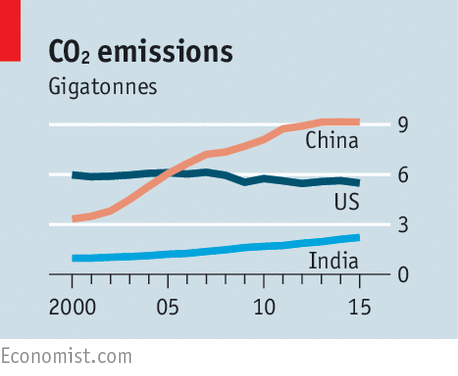
COALMINERS cheered this week when Donald Trump issued an executive order to start unwinding Barack Obama’s flagship climate policies; the new measures include ending a moratorium on the leasing of federal land for mining. “My administration is putting an end to the war on coal,” declared Mr Trump. Yet the black stuff is still in a heap of trouble. In America cheap natural gas has surpassed coal as a source of power generation; no White House ceremony can do much about that. And for all the attention on America, much the more important chapter in the tale of coal’s decline is being written on the other side of the world.
India is the third-largest carbon emitter, after China and America. No fuel matters more to it than coal: it fires up 61% of India’s power-generating capacity and Coal India is the world’s biggest coal company. Since coal generates more carbon emissions when it is burned than other fossil fuels—to say nothing of its effect on air quality—India is a crucial protagonist in the battle against climate change
It has also long been seen as a wild card. On the one hand, the country’s growth projections and justifiable desire to supply power to about 240m Indians who lack it imply that its greenhouse-gas emissions look as if they will almost double. On the other, its plans for solar and wind energy are so ambitious that many have found them hard to believe. But two things suggest that the outlook for coal in India is darkening.
First, the government has declared that it needs no more coal-fired power stations during the next decade than those being built today. About 40% of India’s coal-fired plant capacity is lying idle, because the authorities have overestimated the growth in demand for electricity, and because of the financial weakness of electricity-distribution firms. The pipeline of plants under construction is still a hefty 50 gigawatts (GW), but a portion of these facilities may well be put on hold because of the lousy economics of electricity distribution in India.
Second, Narendra Modi, India’s prime minister, is proving a surprisingly strong advocate for green energy. His government has promised to install fully 175GW of renewable energy by 2022, triple today’s capacity. That ambition, though probably still out of reach, is looking more credible today because of the crashing cost of solar power. In an auction in the state of Madhya Pradesh in February, winning solar bids were competitive with the cost of new coal-fired electricity. Mr Modi’s government recently approved the creation of 50 “solar parks”, with a combined capacity of 40GW.
Dethroning King Coal
Whatever happens, India will still burn a lot of dirty coal. It has many old plants that produce power cheaply, some owned by powerful tycoons who would resist their closure. The amount of unused capacity could fall if growth in power demand accelerates and if the finances of the utilities improve. Pursuing alternatives to coal will meet resistance from unions fearing job losses among miners.
But Mr Modi can also do more to move his country away from coal. Baseload coal power is not good at offsetting the intermittency of sun and wind; India would do better to opt for hydroelectric storage and quick-response natural-gas plants instead. Providing rooftop solar panels to poor communities may be a better way to electrify the country than costly extensions to the grid. Well-prepared land, available grid connections and financial guarantees all encourage the development of solar parks.
Coal is back in favour in America. But India’s second thoughts make for the bigger, and brighter, story.
No comments:
Post a Comment
Note: Only a member of this blog may post a comment.